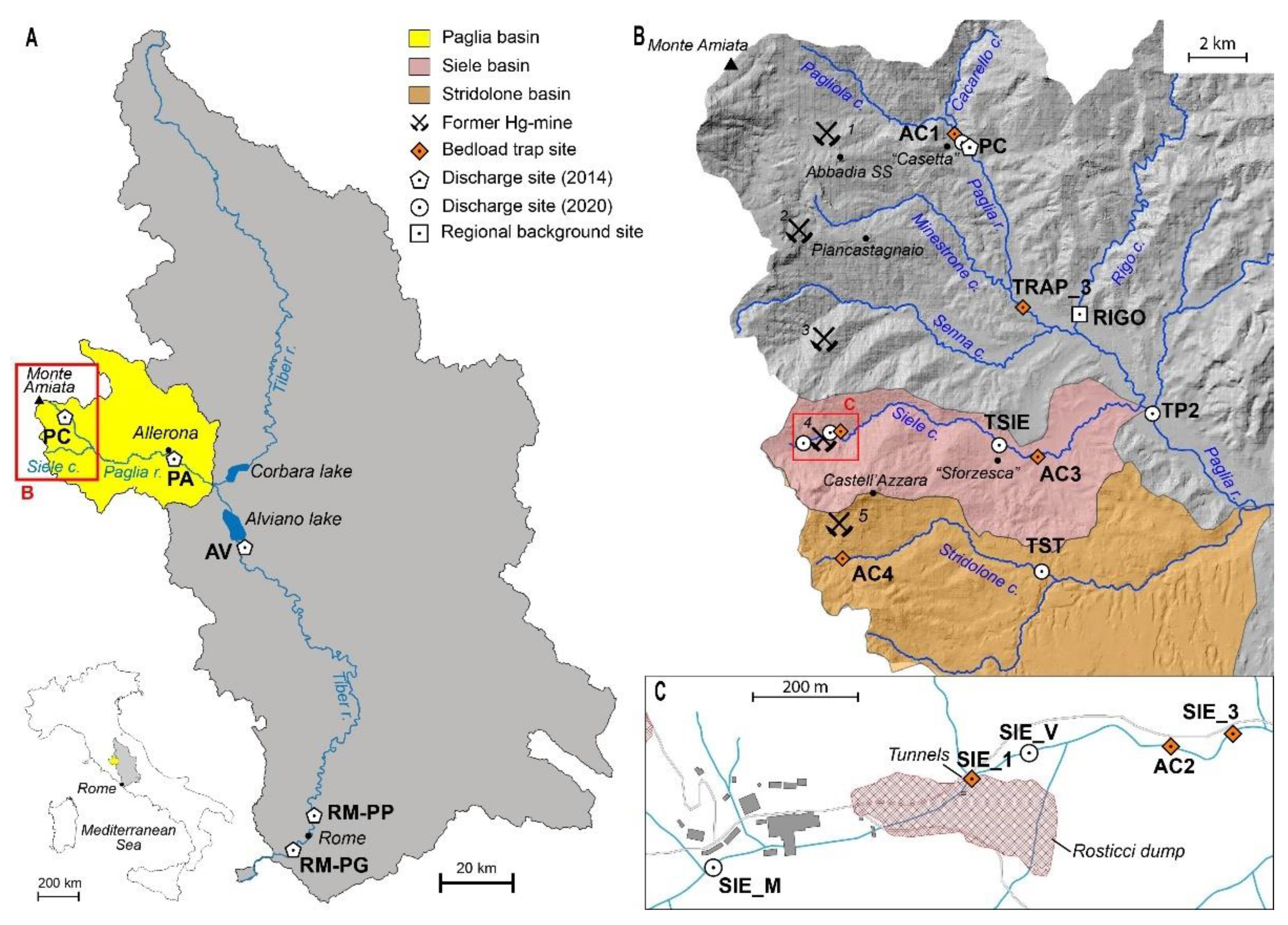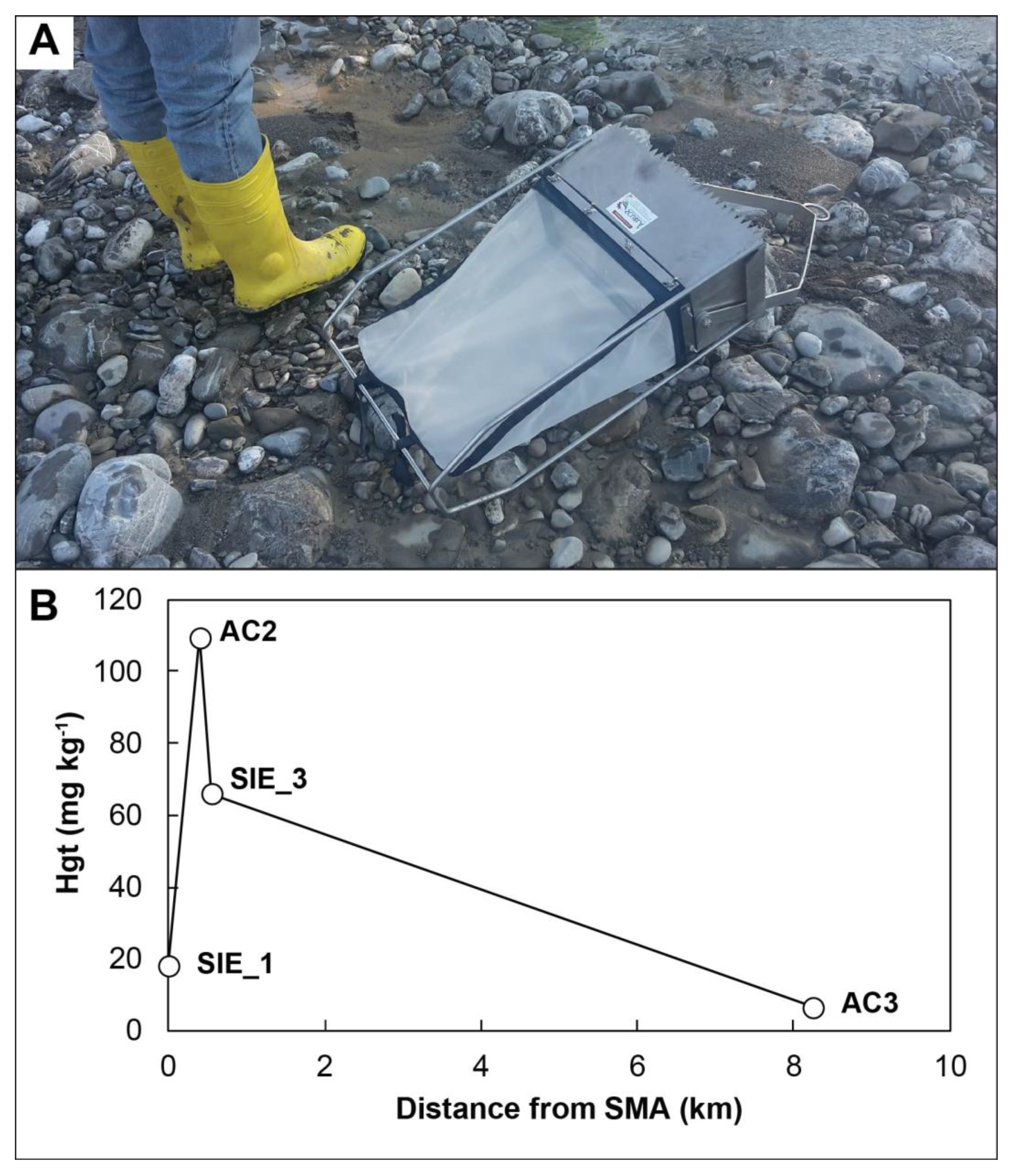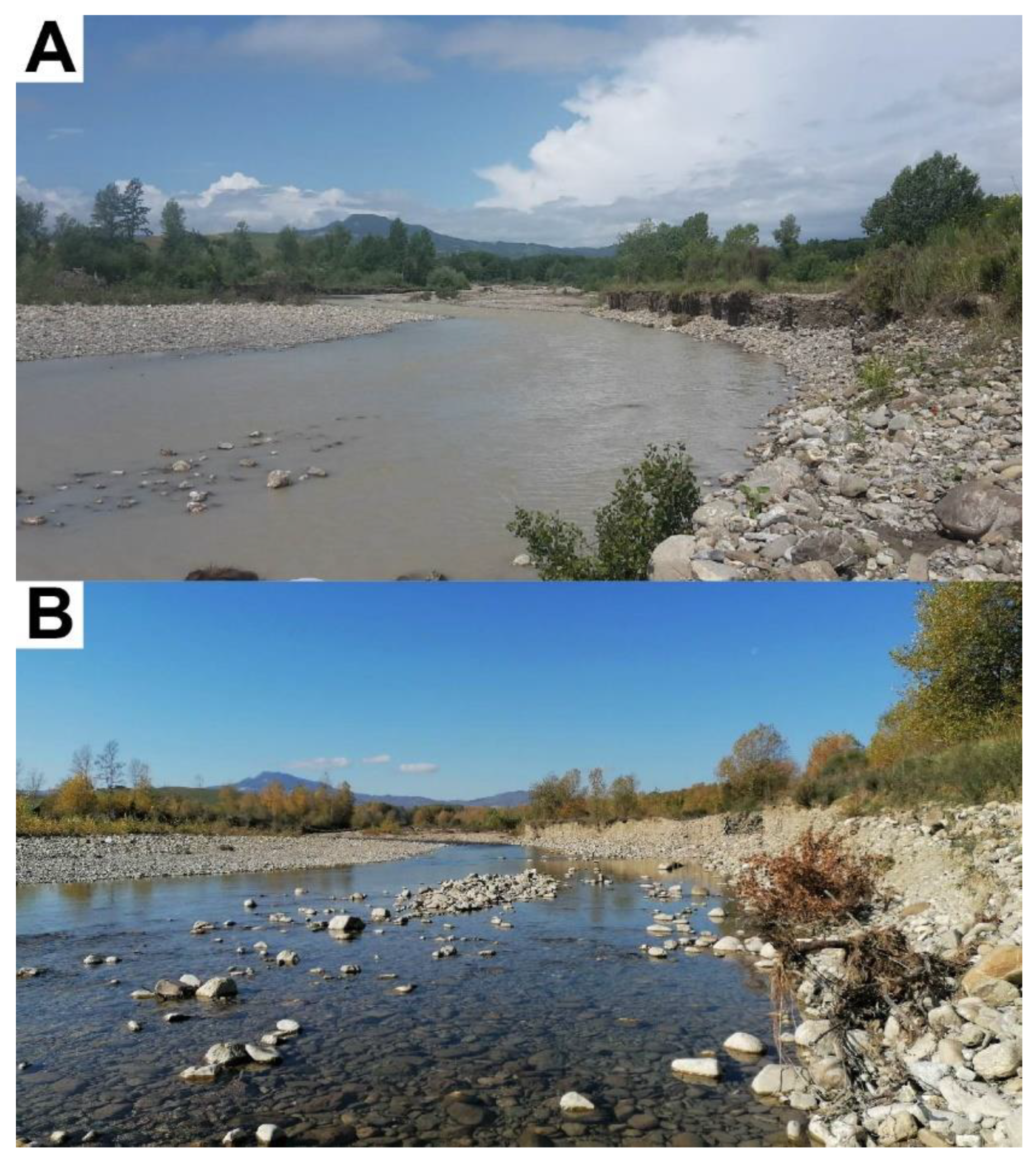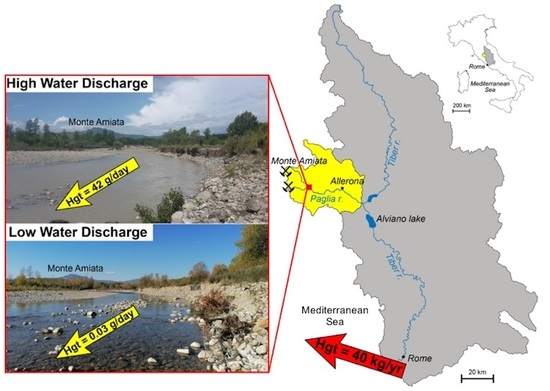Total Mercury Mass Load from the Paglia–Tiber River System: The Contribution to Mediterranean Sea Hg Budget
Abstract
1. Introduction
2. Materials and Methods
2.1. Study Area and Sampling
2.1.1. Study Area
2.1.2. Sampling Sites
- PC: at the Paglia River starting point at the confluence between Pagliola and Cacarello Creeks (same point sampled in 2020)
- PA: along Paglia River, near the town of Allerona, about 40 km from the source and 20 km upstream of the confluence with Tiber River AV: along Tiber River, downstream of the Alviano reservoir
- RM-PP: along Tiber River within the city limits of Rome
- RM-PG: along Tiber River downstream of the city of Rome
- PC: at Paglia River starting point (see above)
- TP2: downstream from confluence with Siele Creek
- SIE_M: upstream of the SMA
- SIE_V: downstream of the SMA, at the exit of the mining site
- TSIE: downstream the SMA, where the steepness decreases, before the confluence with Paglia River
- TST: downstream of the Cornacchino mining area (Figure 1B)
- RIGO: along Rigo Creek before the confluence with Paglia River. At this site, water was collected for total Hg (Hgt), and water discharge was not measured.
2.2. Water Sampling Procedures
2.3. Water Discharge Measurements
2.4. Mercury Mass Load (M-Hg) Calculation
2.5. Bedload Sediment Sampling
- AC1: at the Paglia River starting point
- TRAP_3: after the confluence with Minestrone Creek and before the confluence with Senna Creek
- SIE_1: at the exit of Siele Creek from the mining area
- AC2 and SIE_3: at 400 and 550 m downstream the mining area, respectively
- AC3: about 1 km downstream of the TSIE sampling site
- AC4: downstream the Cornacchino mining area
2.6. Chemical Analyses
3. Results
3.1. Sampling Campaign 2014
3.2. Sampling Campaign 2020
4. Discussion
4.1. The Role of Water Discharge and Geohydrologic Setting on Hg Concentration and Mass Load
4.2. Contribution to Hg-Budget in the Mediterranean Sea
5. Conclusions
Author Contributions
Funding
Institutional Review Board Statement
Informed Consent Statement
Data Availability Statement
Acknowledgments
Conflicts of Interest
References
- Amos, H.M.; Jacob, D.J.; Kocman, D.; Horowitz, H.M.; Zhang, Y.; Dutkiewicz, S.; Sunderland, E.M. Global biogeochemical implications of mercury discharges from rivers and sediment burial. Environ. Sci. Technol. 2014, 48, 9514–9522. [Google Scholar] [CrossRef] [PubMed]
- Širca, A.; Rajar, R.; Harris, R.C.; Horvat, M. Mercury transport and fate in the Gulf of Trieste (Northern Adriatic)—A two-dimensional modelling approach. Environ. Model. Softw. 1999, 14, 645–655. [Google Scholar] [CrossRef]
- Thomas, M.A.; Conaway, C.H.; Steding, D.J.; Marvin-DiPasquale, M.; Abu-Saba, K.E.; Flegal, A.R. Mercury contamination from historic mining in water and sediment, Guadalupe River and San Francisco Bay, California. Geochem. Explor. Environ. Anal. 2002, 2, 211–217. [Google Scholar] [CrossRef]
- Berzas Nevado, J.; Bermejo, L.G.; Martín-Doimeadios, R.R. Distribution of mercury in the aquatic environment at Almadén, Spain. Environ. Pollut. 2003, 122, 261–271. [Google Scholar] [CrossRef]
- Domagalski, J.; Majewski, M.S.; Alpers, C.N.; Eckley, C.S.; Eagles-Smith, C.A.; Schenk, L.; Wherry, S. Comparison of mercury mass loading in streams to atmospheric deposition in watersheds of Western North America: Evidence for non-atmospheric mercury sources. Sci. Total Environ. 2016, 568, 638–650. [Google Scholar] [CrossRef] [PubMed]
- Scanu, S.; Piazzolla, D.; Frattarelli, F.M.; Mancini, E.; Tiralongo, F.; Brundo, M.V.; Marcelli, M. Mercury enrichment in sediments of the coastal area of northern Latium, Italy. Bull. Environ. Contam. Toxicol. 2016, 96, 630–637. [Google Scholar] [CrossRef]
- Rimondi, V.; Costagliola, P.; Lattanzi, P.; Morelli, G.; Cara, G.; Cencetti, C.; Fagotti, C.; Torricelli, S. A 200 km-long mercury contamination of the Paglia and Tiber floodplain: Monitoring results and implications for environmental management. Environ. Pollut. 2019, 255, 113191. [Google Scholar] [CrossRef]
- Cossa, D.; Coquery, M. The Mediterranean Mercury Anomaly, a Geochemical or a BiologocalIssue. In The Mediterranean Sea. Handbook of Environmental Chemistry; Saliot, A., Ed.; Springer: Berlin/Heidelberg, Germany, 2005; Volume 5K. [Google Scholar] [CrossRef]
- Montuori, P.; Aurino, S.; Garzonio, F.; Nardone, A.; Triassi, M. Estimation of heavy metal loads from Tiber River to the Tyrrhenian Sea and environmental quality assessment. Environ. Sci. Pollut. Res. 2016, 23, 23694–23713. [Google Scholar] [CrossRef]
- Rajar, R.; Četina, M.; Horvat, M.; Žagar, D. Mass balance of mercury in the Mediterranean Sea. Mar. Chem. 2007, 107, 89–102. [Google Scholar] [CrossRef]
- Poulier, G.; Launay, M.; Le Bescond, C.; Thollet, F.; Coquery, M.; Le Coz, J. Combining flux monitoring and data reconstruction to establish annual budgets of suspended particulate matter, mercury and PCB in the Rhône River from Lake Geneva to the Mediterranean Sea. Sci. Total Environ. 2019, 658, 457–473. [Google Scholar] [CrossRef]
- Rytuba, J.J. Mercury from mineral deposits and potential environmental impact. Environ. Geol. 2003, 43, 326–338. [Google Scholar] [CrossRef]
- Ferrara, R.; Maserti, B.E.; Andersson, M.; Edner, H.; Ragnarson, P.; Svanberg, S. Mercury degassing rate from mineralized areas in the Mediterranean basin. Water Air Soil Pollut. 1997, 93, 59–66. [Google Scholar] [CrossRef]
- Renzoni, A.; Zino, F.; Franchi, E. Mercury levels along the food chain and risk for exposed populations. Environ. Res. 1998, 77, 68–72. [Google Scholar] [CrossRef]
- Gray, J.E.; Theodorakos, P.M.; Bailey, E.A.; Turner, R.R. Distribution, speciation, and transport of mercury in stream-sediment, stream-water, and fish collected near abandoned mercury mines in southwestern Alaska, USA. Sci. Total Environ. 2000, 260, 21–33. [Google Scholar] [CrossRef]
- Faganeli, J.; Horvat, M.; Covelli, S.; Fajon, V.; Logar, M.; Lipej, L.; Cermelj, B. Mercury and methylmercury in the Gulf of Trieste (northern Adriatic Sea). Sci. Total Environ. 2003, 304, 315–326. [Google Scholar] [CrossRef]
- Covelli, S.; Piani, R.; Acquavita, A.; Predonzani, S.; Faganeli, J. Transport and dispersion of particulate Hg associated with a river plume in coastal Northern Adriatic environments. Mar. Pollut. Bull. 2007, 55, 436–450. [Google Scholar] [CrossRef]
- Canu, D.M.; Rosati, G.; Solidoro, C.; Heimbürger, L.E.; Acquavita, A. A comprehensive assessment of the mercury budget in the Marano–Grado Lagoon (Adriatic Sea) using a combined observational modeling approach. Mar. Chem. 2015, 177, 742–752. [Google Scholar] [CrossRef]
- Vaselli, O.; Higueras, P.; Nisi, B.; Esbrí, J.M.; Cabassi, J.; Martínez-Coronado, A.; Tassi, F.; Rappuoli, D. Distribution of gaseous Hg in the Mercury mining district of Mt. Amiata (Central Italy): A geochemical survey prior the reclamation project. Environ. Res. 2013, 125, 179–187. [Google Scholar] [CrossRef] [PubMed]
- Rimondi, V.; Costagliola, P.; Gray, J.E.; Lattanzi, P.; Nannucci, M.; Paolieri, M.; Salvadori, A. Mass loads of dissolved and particulate mercury and other trace elements in the Mt. Amiata mining district, Southern Tuscany (Italy). Environ. Sci. Pollut. Res. 2014, 21, 5575–5585. [Google Scholar] [CrossRef]
- Pattelli, G.; Rimondi, V.; Benvenuti, M.; Chiarantini, L.; Colica, A.; Costagliola, P.; Di Benedetto, F.; Lattanzi, P.; Paolieri, M.; Rinaldi, M. Effects of the November 2012 flood event on the mobilization of Hg from the Monte Amiata Mining District to the sediments of the Paglia River Basin. Minerals 2014, 4, 241–256. [Google Scholar] [CrossRef]
- Colica, A.; Benvenuti, M.; Chiarantini, L.; Costagliola, P.; Lattanzi, P.; Rimondi, V.; Rinaldi, M. From point source to diffuse source of contaminants: The example of mercury dispersion in the Paglia River (Central Italy). Catena 2019, 172, 488–500. [Google Scholar] [CrossRef]
- Fornasaro, S.; Morelli, G.; Rimondi, V.; Fagotti, C.; Friani, R.; Lattanzi, P.; Costagliola, P. Mercury distribution around the Siele Hg mine (Mt. Amiata district, Italy) twenty years after reclamation: Spatial and temporal variability in soil, stream sediments, and air. J. Geochem. Explor. 2022, 232, 106886. [Google Scholar] [CrossRef]
- Fornasaro, S.; Morelli, G.; Rimondi, V.; Fagotti, C.; Friani, R.; Lattanzi, P.; Costagliola, P. The extensive mercury contamination in soil and legacy sediments of the Paglia River basin (Tuscany, Italy): Interplay between Hg-mining waste discharge along rivers, 1960s economic boom, and ongoing climate change. J. Soils Sediments 2022, 22, 656–671. [Google Scholar] [CrossRef]
- Fornasaro, S.; Morelli, G.; Rimondi, V.; Fagotti, C.; Lattanzi, P.; Costagliola, P. A GIS-based map of the Hg-impacted area in the Paglia River basin (Monte Amiata Mining District–Italy): An operational instrument for local authorities. J. Geochem. Explor. 2022. under review. [Google Scholar]
- Lattanzi, P.; Benvenuti, M.; Chiarantini, L.; Colica, A.; Costagliola, P. Mercury fluxes from the abandoned Monte Amiata mining district in the Paglia and Tiber River catchments, Central Italy: Preliminary estimates. In Proceedings of the EGU General Assembly 2020, Online, 4–8 May 2020. EGU2020-11361. [Google Scholar] [CrossRef]
- Directive, W.F. Water Framework Directive. J. Ref. OJL 2000, 327, 1–73. [Google Scholar]
- Camici, S.; Tarpanelli, A.; Brocca, L.; Melone, F.; Moramarco, T. Design soil moisture estimation by comparing continuous and storm-based rainfall-runoff modeling. Water Resour. Res. 2011, 47, W05527. [Google Scholar] [CrossRef]
- Minissi, S.; Lombi, E. Heavy metal content and mutagenic activity, evaluated by Vicia faba micronucleus test, of Tiber River sediments. Mutat. Res. Toxicol. Environ. Mutagen. 1997, 393, 17–21. [Google Scholar] [CrossRef]
- Bettinetti, R.; Galassi, S.; Guilizzoni, P.; Quadroni, S. Sediment analysis to support the recent glacial origin of DDT pollution in Lake Iseo (Northern Italy). Chemosphere 2011, 85, 163–169. [Google Scholar] [CrossRef]
- Patrolecco, L.; Capri, S.; Ademollo, N. Occurrence of selected pharmaceuticals in the principal sewage treatment plants in Rome (Italy) and in the receiving surface waters. Environ. Sci. Pollut. Res. 2014, 22, 5864–5876. [Google Scholar] [CrossRef]
- Girotti, O.; Mancini, M. Plio-Pleistocene stratigraphy and relations between marine and non-marine successions in the Middle Valley of the Tiber River (Latium, Umbria). Il Quat. 2003, 16, 89–106. (In Italian) [Google Scholar]
- Cencetti, C.; De Rosa, P.; Fredduzzi, A.; Tacconi, P. L’approccio morfologico-sedimentario nello studio dei corsi d’acqua: Dinamica fluviale, processi di erosione, rischio da dinamica d’alveo e rischio idraulico. In Atti del Convegno “Dal Fiume al Mare—Ripensare il Litorale Romano Secondo Natura” (Ostia, 12 Ottobre 2019). Collana “Culture, Territori, Linguaggi”; Cencetti, C., Ruggiero, D., Eds.; Università degli Studi di Perugia: Perugia, Italy, 2020; Volume 18, pp. 25–52. ISBN 9788894469721. Available online: http://www.ctl.unipg.it/issues/CTL_18.pdf (accessed on 5 May 2021). (In Italian)
- Boila, P.; Lavecchia, G.; Giaquinto, S.; Pialli, G. Caratteri geologico-strutturali del bacino del Fiume Paglia (Umbria-Toscana). Progett. Final. Energetica CNR—Sottoprogetto Energ. Geoterm. (CNR). Relaz. Final. 1982, 16, 7–32. (In Italian) [Google Scholar]
- Damiani, A.V.; Mencarelli, I. Controlli strutturali subiti dalla sedimentazione “etrusca” affiorante nella finestra tettonica del M. Peglia (Umbria di SW). Rend. Soc. Geol. It 1990, 13, 147–150. (In Italian) [Google Scholar]
- Marra, F.; Costantini, L.; Di Buduo, G.; Florindo, F.; Jicha, B.; Monaco, L.; Palladino, D.; Sottili, G. Combined glacio-eustatic forcing and volcano-tectonic uplift: Geomorphological and geochronological constraints on the Tiber River terraces in the eastern Vulsini Volcanic District (central Italy). Glob. Planet. Chang. 2019, 182, 103009. [Google Scholar] [CrossRef]
- Regione Toscana, 2019 Carta Dell’uso del Suolo, Scale 1:10.000. Available online: http://www502.regione.toscana.it/geoscopio/usocoperturasuolo.html (accessed on 5 May 2021).
- Regione Lazio, 2000 Carta Dell’uso del Suolo. Assessorato Urbanistica e Casa–Regione Lazio. Scala 1:25,000 Regione Lazio, Roma, Italy. Available online: https://dati.lazio.it/catalog/it/dataset/carta-tecnica-regionale-1979-1980-25k (accessed on 7 July 2021).
- Marroni, M.; Moratti, G.; Costantini, A.; Conticelli, S.; Benvenuti, M.G.; Pandolfi, L.; Laurenzi, M.A. Geology of the Monte Amiata region, Southern Tuscany, Central Italy. Ital. J. Geosci. 2015, 134, 171–199. [Google Scholar] [CrossRef]
- Ciccacci, S.; Galiano, M.; Roma, M.A.; Salvatore, M.C. Morphodynamics and morphological changes of the last 50 years in a badland sample area of Southern Tuscany (Italy). Z. Geomorphol. 2009, 53, 273–297. [Google Scholar] [CrossRef]
- Moretti, G.P.; Cianficconi, F.; Peroni, E.; Ronca, M. Considerazioni sulle comunità macrobentoniche del sistema fluviale Paglia-Chiani. Boll. Mus. Sto. Nat. Lunigiana 1988, 67, 157161. [Google Scholar]
- Di Tria, L.; Grimaldi, S.; Napolitano, F.; Ubertini, L. Rainfall forecasting using limited area models and stochastic models. In Proceedings of the EGS Plinius Conference, Maratea, Italy, 14–16 October 1999; Volume 1416, p. 193204. [Google Scholar]
- Rimondi, V.; Gray, J.E.; Costagliola, P.; Vaselli, O.; Lattanzi, P. Concentration, distribution, and translocation of mercury and methylmercury in mine-waste, sediment, soil, water, and fish collected near the Abbadia San Salvatore mercury mine, Monte Amiata district, Italy. Sci. Total Environ. 2012, 414, 318–327. [Google Scholar] [CrossRef]
- Rimondi, V.; Bardelli, F.; Benvenuti, M.; Costagliola, P.; Gray, J.E.; Lattanzi, P. Mercury speciation in the Mt. Amiata mining district (Italy): Interplay between urban activities and mercury contamination. Chem. Geol. 2014, 380, 110–118. [Google Scholar] [CrossRef]
- Regione Toscana. SIR, Settore Idrologico e Geologico Regionale. 2020. Available online: www.sir.toscana.it (accessed on 14 June 2021).
- US-EPA. Method 1669: Technical Guidance-Sampling and Analysis of Ambient Waters for Trace Metals at EPA Water Quality Criteria Levels. 1996. Available online: https://www.epa.gov/sites/production/files/2015-10/documents/method_1669_1996.Pdf (accessed on 20 November 2021).
- Kimball, B.A. Use of tracer injections and synoptic sampling to measure metal loading from acid mine drainage. In U.S. Geological Survey Fact Sheet FS-245-96; U.S. Geological Survey: Reston, VA, USA, 1997. [Google Scholar]
- UNI EN ISO 748: 2008; Hydrometry—Measurement of liquid flow in open channels using current-meters or floats. Ente Nazionale Italiano di Unificazione (UNI): Milan, Italy, 2008; 46p.
- Pavoni, E.; Petranich, E.; Signore, S.; Fontolan, G.; Covelli, S. The Legacy of the Idrija Mine Twenty-Five Years after Closing: Is Mercury in the Water Column of the Gulf of Trieste Still an Environmental Issue? Int. J. Environ. Res. Public Health 2021, 18, 10192. [Google Scholar] [CrossRef]
- US-EPA. Method 1631: Mercury in Water by Oxidation, Purge and Trap, and Cold Vapor Atomic Fluorescence Spectrometry. 2002. Available online: https://www.epa.gov/sites/production/files/2015-08/documents/method_1631e_2002.pdf (accessed on 20 November 2021).
- US-EPA. Method 3051A (SW-846): Microwave Assisted Acid Digestion of Sediments, Sludges, and Oils, Revision 1. Washington, DC, USA. 2007. Available online: https://www.epa.gov/esam/us-epa-method-3051a-microwave-assisted-acid-digestion-sediments-sludges-and-oils (accessed on 20 November 2021).
- US-EPA. Method 6010D (SW-846): Inductively Coupled Plasma-Optical Emission Spectrometry, SW-846. 2018. Available online: https://www.epa.gov/esam/epa-method-6010d-sw-846-inductively-coupled-plasma-atomic-emission-spectrometry (accessed on 20 November 2021).
- Gray, J.E.; Rimondi, V.; Costagliola, P.; Vaselli, O.; Lattanzi, P. Long-distance transport of Hg, Sb, and As from a mined area, conversion of Hg to methyl-Hg, and uptake of Hg by fish on the Tiber River basin, west-central Italy. Environ. Geochem. Health 2013, 36, 145–157. [Google Scholar] [CrossRef]
- Zolkos, S.; Krabbenhoft, D.P.; Suslova, A.; Tank, S.E.; McClelland, J.W.; Spencer, R.G.; Holmes, R.M. Mercury export from Arctic great rivers. Environ. Sci. Technol. 2020, 54, 4140–4148. [Google Scholar] [CrossRef]
- Baptista-Salazar, C.; Biester, H. The role of hydrological conditions for riverine Hg species transport in the Idrija mining area. Environ. Pollut. 2019, 247, 716–724. [Google Scholar] [CrossRef] [PubMed]
- Salomons, W.; Förstner, U. Sediments and the transport of metals. In Metals in the Hydrocycle; Springer: Berlin/Heidelberg, Germany, 1984; pp. 63–98. [Google Scholar]
- Schäfer, J.; Blanc, G.; Audry, S.; Cossa, D.; Bossy, C. Mercury in the Lot–Garonne River system (France): Sources, fluxes and anthropogenic component. Appl. Geochem. 2006, 21, 515–527. [Google Scholar] [CrossRef][Green Version]
- Wei, L.; Liu, Y.; Cai, D.; Li, F.; Luo, D.; Li, C.; Xu, G.; Xiao, T.; Wu, Q.; He, H.; et al. River morphology redistributes potentially toxic elements in acid mine drainage-impacted river sediments: Evidence, causes, and implications. Catena 2022, 214, 106183. [Google Scholar] [CrossRef]
- Rayne, S.; Friesen, K. Contaminant trapping behind large Dams: A mini-Review. Nat. Preced. 2009, 1–13. [Google Scholar] [CrossRef]
- Castelle, B.; Bonneton, P.; Dupuis, H.; Sénéchal, N. Double bar beach dynamics on the high-energy meso-macrotidal French Aquitanian Coast: A review. Mar. Geol. 2007, 245, 141–159. [Google Scholar] [CrossRef]
- Diodato, N.; Ljungqvist, F.C.; Bellocchi, G. A millennium-long climate history of erosive storms across the Tiber River Basin, Italy, from 725 to 2019 CE. Sci. Rep. 2021, 11, 20518. [Google Scholar] [CrossRef]
- Ollivier, J.; Töwe, S.; Bannert, A.; Hai, B.; Kastl, E.M.; Meyer, A.; Schloter, M. Nitrogen turnover in soil and global change. FEMS Microbiol. Ecol. 2011, 78, 3–16. [Google Scholar] [CrossRef]
- Coynel, A.; Schäfer, J.; Hurtrez, J.E.; Dumas, J.; Etcheber, H.; Blanc, G. Sampling frequency and accuracy of SPM flux estimates in two contrasted drainage basins. Sci. Total Environ. 2004, 330, 233–247. [Google Scholar] [CrossRef]
- Chiang, F.; Mazdiyasni, O.; AghaKouchak, A. Evidence of anthropogenic impacts on global drought frequency, duration, and intensity. Nat. Commun. 2021, 12, 2754. [Google Scholar] [CrossRef]
- Romano, E.; Petrangeli, A.B.; Salerno, F.; Guyennon, N. Do recent meteorological drought events in central Italy result from long-term trend or increasing variability? Int. J. Climatol. 2021, 42, 4111–4128. [Google Scholar] [CrossRef]
- Castellari, S.; Venturini, S.; Giordano, F.; Ballarin Denti, A.; Bigano, A.; Bindi, M.; Zavatarelli, M. Elementi per una Strategia Nazionale di Adattamento ai Cambiamenti Climatici; Ministero dell’Ambiente e della Tutela del Territorio e del Mare: Roma, Italy, 2014. (In Italian) [Google Scholar]
- Giorgi, F.; Lionello, P. Climate change projections for the Mediterranean region. Glob. Planet. Chang. 2008, 63, 90–104. [Google Scholar] [CrossRef]
- Vicente-Serrano, S.M.; Quiring, S.M.; Peña-Gallardo, M.; Yuan, S.; Domínguez-Castro, F. A review of environmental droughts: Increased risk under global warming? Earth-Sci. Rev. 2020, 201, 102953. [Google Scholar] [CrossRef]




| Id | River/Creek | Latitude | Longitude | Campaign |
|---|---|---|---|---|
| PC | Pagliola | 42.88291 | 11.72913 | 2014; 2020 |
| TP2 | Paglia | 42.79536 | 11.80698 | 2020 |
| PA | Paglia | 42.77540 | 12.04620 | 2014 |
| AV | Tiber | 42.58313 | 12.25053 | 2014 |
| RM-PP | Tiber | 41.88342 | 12.47536 | 2014 |
| RM-PG | Tiber | 41.80527 | 12.34677 | 2014 |
| SIE_M | Siele | 42.78945 | 11.66759 | 2020 |
| SIE_V | Siele | 42.78944 | 11.66758 | 2020 |
| TSIE | Siele | 42.78700 | 11.74366 | 2020 |
| TST | Stridolone | 42.74460 | 11.76372 | 2020 |
| RIGO | Rigo | 42.82961 | 11.77992 | 2020 |
| Period | 9–16 September 2014 | 1–8 June 2020 | 29 October–5 November 2020 |
|---|---|---|---|
| Cumulate | 51.8 | 95.2 | 0.8 |
| Daily Average | 6.47 | 19.04 | 0.2 |
| Raining days | 4 | 4 | 0 |
| Daily max | 22 | 65 | 0.2 |
| Q | TSS | Hgt | Hgd | Hgp | M-Hgt | M-Hgd | M-Hgp | |
|---|---|---|---|---|---|---|---|---|
| L s−1 | mg L−1 | ng L−1 | ng L−1 | ng L−1 | g day−1 | g day−1 | g day−1 | |
| September 2014 | ||||||||
| PC | 190 | - | 316 | 6.0 | 310 | 5 | 0.1 | 5 |
| PA | 1530 | - | 8.0 | 3.0 | 4.0 | 1 | 0.5 | 0.6 |
| AV | 57,000 | - | 45 | 2.0 | 43 | 223 | 9 | 214 |
| RM-PP | 87,000 | - | 12 | - | - | 91 | - | - |
| RM-PG | 87,000 * | - | 15 | 2.0 | 13 | 112 | 13 | 99 |
| June 2020 | ||||||||
| PC | 285 | - | 89 | - | - | 2 | - | - |
| TP2 | 2700 | - | 181 | - | - | 42 | - | - |
| SIE_M | 15 ** | - | 103 | - | - | 0.1 | - | - |
| SIE_V | 17 | - | 1601 | - | - | 2 | - | - |
| TSIE | 139 | - | 50 | - | - | 0.6 | - | - |
| TST | 11 | - | 18 | - | - | 0.02 | - | - |
| RIGO | - | - | 43 | - | - | - | - | - |
| November 2020 | ||||||||
| PC | 13 | 0.5 | 2.4 | 0.2 | 2.2 | 0.003 | 0.0003 | 0.002 |
| TP2 | 454 | 1.5 | 0.8 | - | 2.3 | 0.03 | - | 0.09 |
| SIE_M | - | - | - | - | - | - | - | - |
| SIE_V | 4 | 0.7 | 603 | 401 | 202 | 0.2 | 0.1 | 0.07 |
| TSIE | 63 | 0.2 | 14 | 12 | 2.3 | 0.08 | 0.07 | 0.01 |
| TST | 32 | 0.3 | 38 | 36 | 1.8 | 0.1 | 0.1 | 0.005 |
| RIGO | - | - | <1 | - | - | - | - | - |
| Id | Working Period | Hgt (mg kg−1) | Latitude | Longitude |
|---|---|---|---|---|
| Siele Creek | ||||
| SIE_1 | June–October 2020 | 18 | 42.78961 | 11.66757 |
| AC2 | February 2019 | 110 | 42.78996 | 11.67208 |
| SIE_3 | June–July 2020 | 66 | 42.79017 | 11.67375 |
| AC3 | August 2019 | 6.3 | 42.78271 | 11.76357 |
| Paglia River | ||||
| AC1 | September 2018 | 2.0 | 42.88305 | 11.72879 |
| TRAP_3 | January–February 2020 | 23 | 42.82958 | 11.75200 |
| Stridolone Creek | ||||
| AC4 | February 2019 | 290 | 42.75318 | 11.67045 |
Publisher’s Note: MDPI stays neutral with regard to jurisdictional claims in published maps and institutional affiliations. |
© 2022 by the authors. Licensee MDPI, Basel, Switzerland. This article is an open access article distributed under the terms and conditions of the Creative Commons Attribution (CC BY) license (https://creativecommons.org/licenses/by/4.0/).
Share and Cite
Fornasaro, S.; Morelli, G.; Costagliola, P.; Rimondi, V.; Lattanzi, P.; Fagotti, C. Total Mercury Mass Load from the Paglia–Tiber River System: The Contribution to Mediterranean Sea Hg Budget. Toxics 2022, 10, 395. https://doi.org/10.3390/toxics10070395
Fornasaro S, Morelli G, Costagliola P, Rimondi V, Lattanzi P, Fagotti C. Total Mercury Mass Load from the Paglia–Tiber River System: The Contribution to Mediterranean Sea Hg Budget. Toxics. 2022; 10(7):395. https://doi.org/10.3390/toxics10070395
Chicago/Turabian StyleFornasaro, Silvia, Guia Morelli, Pilario Costagliola, Valentina Rimondi, Pierfranco Lattanzi, and Cesare Fagotti. 2022. "Total Mercury Mass Load from the Paglia–Tiber River System: The Contribution to Mediterranean Sea Hg Budget" Toxics 10, no. 7: 395. https://doi.org/10.3390/toxics10070395
APA StyleFornasaro, S., Morelli, G., Costagliola, P., Rimondi, V., Lattanzi, P., & Fagotti, C. (2022). Total Mercury Mass Load from the Paglia–Tiber River System: The Contribution to Mediterranean Sea Hg Budget. Toxics, 10(7), 395. https://doi.org/10.3390/toxics10070395










